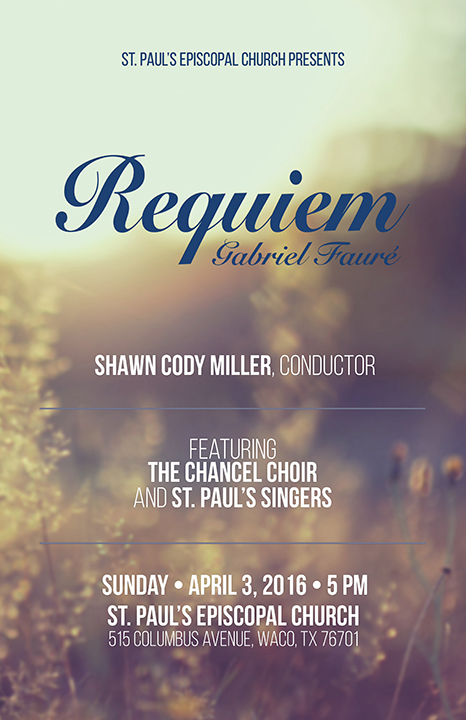An ensemble featuring the Chancel Choir and St. Paul’s Singers will perform Gabriel Faure’s “Requiem” at 5 p.m. Sunday at St. Paul’s Episcopal Church.
The choir will be directed by Shawn Cody Miller, Baylor graduate conductor of a cappella choir and chamber singers and associate director of music at St. Paul’s. It will include nearly 20 choir members. The instrumentalists include Baylor organ professor Dr. Isabelle Demers and a few horn students. The string players consist of teachers and students of the Central Texas String Academy as well as harpist Katherine Kappelmann.
The “Requiem in D minor, Op. 48,” is one of Faure’s best known works. It was created during his time as an organist at the L’eglise de la Madeleine in Paris. The composition was created for an annual mass and originally consisted of five movements, scored for only low strings and organ.
The piece being performed on Sunday will include seven movements and was completed in 1893. The version extended the amount of instrumentalists to a slightly larger string section and the addition of brass.
Many consider the 1893 construction to be the final product that Faure intended, said Miller, but the piece was not given publishing rights until it was changed to accommodate a full orchestra in 1900.
“It’s one of the top five standard requiems in Western music, and it’s accessible,” Miller said. “It’s simple because it strives to achieve that affect of being consoling and peaceful. Therefore it’s not really intense writing, which can make other requiems too challenging for a church choir to do.”
The ensemble began practicing the “Requiem” in early February. In addition to rehearsing pieces for the service, the group would practice for about an hour every Sunday morning.
Coppell senior Sarah Hernandez is looking forward to the performance.
“I’ve always been really excited to sing it ,and this is my first opportunity to work with the piece,” Hernandez said. “Personally, I like the Credo because that’s the apostle’s creed, and we hear it all the time in church— because I grew up Catholic and to be able to sing it and to put the creed that I know in Latin with the text [makes it] really cool to see what Faure does with that.”
Miller feels that this piece is different from other requiems, not just in length, but also in meaning.
“Many parts of the Requiem Mass that pulls from the Catholic liturgy are not very peaceful. For instance the ‘Dies Irae’ — ‘The Day of Wrath’ — is aggressive and is in most requiem settings. But Faure intentionally left out that movement and added in other movements to achieve the affects he wanted, which was one of more peace and not necessarily a day of judgment, but eternal rest,” Miller said.






